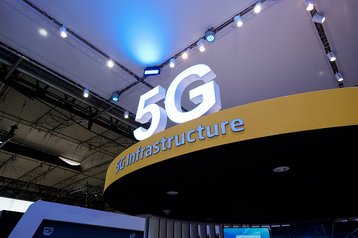Telcos and mobile network operators (MNOs) across the world are finalising preparations to launch commercial fifth generation (5G) networks that will bring more bandwidth and lower latency to a wide variety of business and consumer applications in 2020 and beyond.
Faster smartphone Internet access is only one of the many uses 5G can serve – others include fixed wireless broadband links, Internet of Things (IoT) connectivity, conferencing and collaboration applications and private 5G networks. But to support the massive increase in devices being connected, operators need to fundamentally rethink how they architect their network infrastructure to deliver the bandwidth and access speed customers will demand while keeping implementation and running costs to a minimum to keep the services they provide cost effective and sustainable.
Moving ever closer to the edge
Telefónica is currently rolling out 5G across its European footprint. That includes the UK where its 02 subsidiary is implementing infrastructure upgrades designed to make sure it has the coverage and capacity to support vast numbers of 5G devices when spectrum and handsets become available next year.
Both 02 and Telefónica are targeting a wide range of applications and vertical industries for initial 5G adoption. These include smart city/building deployments, cloud collaboration, remote healthcare monitoring and virtual reality assisted video conferencing, video gaming, automotive and manufacturing.
But to support devices such as connected vehicles and production robots alongside cached streaming of video and games, the telco knows that both its cloud data centre and core mobile functionality will have to be distributed to locations which are closer to end users to deliver the required performance.
“Distribution of mobile core and edge computing capabilities for 5G is key for latency sensitive, video rich and sensor data applications,” explained Peter Linder, head of 5G marketing for Ericsson North America Telefónica.
Higher density 5G brings new power requirements
Telefónica has also made a firm commitment to reduce its carbon emissions by more than 50 percent between 2020 and 2030. Its Energy and Climate Change plan aims to reduce its operational costs and align its network expansion with a sustainable strategy going forwards.
Maintaining that ambition whilst simultaneously rolling out 5G infrastructure will be difficult however. Research suggests most telecommunications professionals think that 5G is likely to increase telco and mobile operators’ power consumption given the additional equipment and sites needed to provide greater coverage density.
A survey of 100 global telecoms operators conducted last year by analyst firm 451 found 94 percent believed 5G would raise their overall energy costs. Internal analysis conducted by data centre infrastructure specialist Vertiv (previously the data centre power business unit of Emerson Network Power) estimated that the move to 5G could result in increased total network energy consumption of 150-170 percent by 2026.
Nilmar Seccomandi David is head of network and system infrastructure at Telefónica’s global CTIO unit. He too feels that moving to 5G and edge computing will “most likely” increase its network energy consumption. The operator is currently examining various ways to minimize that impact, including new cooling systems to improve thermal safety, greater use of renewal energy supplies, virtualized radio cores and remote infrastructure management platforms.
Distributed access networks will change the game
There is increasing realization that a new distributed access network architecture will be needed to replace the traditional centralized data centre topology. Edge computing will play a pivotal role here, making sure Telefónica and others can deliver extra the capacity and coverage needed to optimize 5G service delivery without increasing its energy footprint.
“Edge computing requires a key component: end to end resiliency providing in edge data centres at last the same (or more) levels of reliability implemented in large data centres … based upon areas like climate control solutions, remote management and power consumption,” explained Seccomandi David.
Additional sites need efficient power management
The augmented capacity, bandwidth and latency requirements needed to take 5G networks beyond existing 4G/LTE provision will almost certainly need higher density infrastructure built on additional wireless antennas and base stations to mobile traffic at the edge.
With existing sites needing to support more equipment, telecoms operators need to think more carefully about how partition existing power supplies to optimize their thermal density and cost efficiency, particularly when it comes to managing a gradual 4G to 5G transition that will need both new and legacy infrastructure approaching the end of its service life to co-exist side by side in the short term.
Many will also need to acquire extra sites at which to install radio equipment, with all the associated challenges of sourcing enough electricity to feed them and providing power backup options such as generators to ensure resiliency and failover.
Almost half (45 percent) of those polled by 451 felt that site acquisition and availability were two of the most important factors which will determine the success of 5G due to additional infrastructure density requirements.
Ericsson’s Linder points out that the need to increase power efficiency per site as the number of antennae and base stations increases is crucial to ensuring MNOs can either maintain or reduce their existing consumption in order to keep down the cost of deployment as well as ongoing 5G operations
“Power supply today is focused on macro radio sites and centralized core sites. 5G bring a larger number of sites to power and a need to reduce power needs during idle or low traffic situations,” he said.
Gradual evolution ramps up pressure
A more innovative approach to power management within both 5G network infrastructure and changes in the way telecoms operators procure and supply electricity to 5G networks will become crucial as they expand capacity and coverage over the next five years.
The growing volumes of devices expected to come online due to exponential growth in IoT/M2M connectivity, aligned with huge volumes of video data, will put steadily increasing pressure on infrastructure from day one, beginning early next year.
Most agree it is better to build the 5G business model from the ground up and be prepared for those challenges by looking for ways to reduce electricity consumption now rather than see service rollouts delayed if and when hurdles are hit at a later stage. For that to happen, telecoms operators need to firstly make a thorough assessment of their existing network infrastructure to see if upgrades are required and/or feasible and where and how power savings can be most effectively achieved.





